The Asylum. What began as treatment facilities and sanctuaries for the mentally ill quickly devolved into places of neglect and cruelty. A dark symbol of humanity’s struggle to comprehend the mind’s deepest mysteries within. This is the setting of SEANCE IN THE ASYLUM, the newest Dark Horse comic written by Clay McLeod Chapman and drawn by Leonardo Marcello Grassi. It is a story based on the actual historical practice of using spiritualism to dispel our mental health demons. Here’s the premise:
1865. Defrauded spiritual medium Alicia Wilkinson is brought to The Ashcroft Hospital at the behest of Dr. John James Templeton. He offers Alicia a second chance to revive her once-thriving career: Perform a séance amongst the patients in order to drawing out their mental maladies. Alicia performs her first series of séances with the patients—including traumatized soldiers returning from the Civil War, women whose sanity has slipped through their fingers—only to realize their sessions might work all too well. What no one knows is Alicia is a fake. A liar. A cheat… So why are the patients suddenly acting possessed?
I chatted with Clay Mcleod Chapman about SEANCE IN THE ASYLUM #1. You can read our official talk below.
This interview has been edited for clarity.
CHRISTIAN ANGELES: Clay, this is a safe space. Between you and me… Do you see dead people?
CLAY MCLEOD CHAPMAN: I want to see dead people! I think there’s just too many dead people in my head and not enough around my house. I don’t know if I want to believe in ghosts but they are so much fun to play with.
ANGELES: Now I read that you actually read The Homeopathic Principle Applied to Insanity: A proposal to Treat Lunacy by Spiritualism for this story. That true?
CHAPMAN: Yes. I was doing research for my novel Ghost Eaters, and I was reading this book called Common Phantoms: An American history of Psychic Science by Alicia Puglionesi. She mentioned The Homeopathic Principle in passing, like it was a footnote in her book, and I was like, “What is that? This sounds amazing.”
So I dug it up. I read it and oh my god. I knew then and there that this is A: Crazy. But B: Amazing. And C: a story that I had to write. It’s from 1857 so it’s out there in the common law (free use) and in the The Homeopathic Principle, Doctor Wilkinson goes to some pretty bonkers places. For a hot minute he genuinely believed spiritualism and summoning spirits from beyond the veil could help provide a therapeutic curative for mentally infirmed patients.
ANGELES: I mean for all we know, it could. It’s like exposure therapy right? You face your demons, quite literally, face to face.
CHAPMAN: This was kind of the gothic. Antiquated version. My God, can you imagine?
ANGELES: That’s exactly what you’d imagined in this book. Like what if it did…
CHAPMAN: Then it works!
<laughs>
ANGELES: Okay. Comics are a visual medium. I have to ask your first issue feels intentionally symbolic. What’s with your love of seances and summoning circles?
CHAPMAN: I mean, I am obsessed with seances. I fanboy on the Fox sisters. I just have this fascination with spiritualism and the kind of antiquated process of contacting the dead.
For my writing, I just kind of use these stories as opportunities to kind of explore my own obsessions get them out of my system. But seances and spiritualism? I’m going back to it time and time again until somebody else cuts me off.
It’s also just wonderful to be kind of gifted the opportunity of playing within the visual medium. Working with Leonardo and seeing his art, his ability to create a visual rendition of a seance. I’ve been stuck writing about seances or writing versions of seances. This is as close to visualizing one as I’ve gotten in a while.
ANGELES: Alright for those who don’t know, who are the Fox sisters?
CHAPMAN: So Kate and Maggie Fox, I think they were 9 and 11 years old at the turn of the century, were these two little girls that believed or claimed that they heard were in contact with a ghost in the basement of their house. They said that they could communicate with this ghost, and it led to a certain kind of ripple effect where, based on their claims, these two girls kind of created an industry of contacting the dead and communicating with those who had passed on.
Given the fact that this was at the tail end of the Civil War, we as a country were faced with death on such a cataclysmic, wholesale status. Sons, brothers, husbands, fathers were all coming home and pine boxes, if they were coming home at all. There was this great need for saying goodbye, establishing some sort of supernatural bridge to those that that people had lost, and saying I love you for one last time.
The fox sisters claimed they could do that. Said they can do all those things that you weren’t able to do because you lost your son on the battlefield or if you didn’t get a chance to say goodbye or I Love you that one last time to your father or your husband.
Whether or not you believe in spiritualism as an actual religious movement or process, these two little girls were at the forefront of what became a belief system. A religious movement. It’s been debunked since but people still believe. And I think it’s fun to believe.
ANGELES: There’s this term, “Fake it till ya make it.” I feel like that’s sort of the premise you’ve built here with the allegedly failed spiritual medium, Alicia Wilkinson. What’s her story? And what can you tell us about her?
CHAPMAN: I mean, Alicia is kind of my rendition of the Fox sisters and kind of follows a similar career trajectory where Alicia as a young girl was hitting up the spiritualism circuit and performing seances for those people who had lost loved ones in the Civil War but had been exposed and debunked by members of the scientific and medical profession. Which in of itself was kind of a thread of the Fox sisters narrative in personal history, where all of these doctors just love to come after them.
We see Alicia kind of at rock bottom, where she’s no longer at the height of her spiritualist career. So she takes this job at a mental institution in upstate New York, where she’s asked to come in and lead a seance for this particular group of patients, in hopes of summoning the voices within their head and casting them out… And maybe it works a little too well.
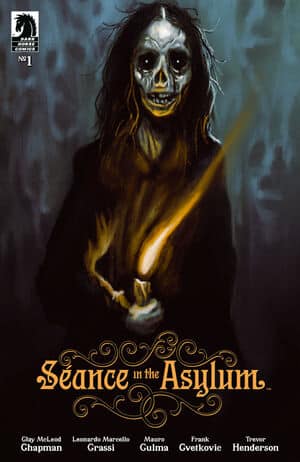
CHAPMAN: I mean, it’s riffing off of Wilkinson’s theories. We’re talking like post Civil War that’s just ending. So it’s early to mid 1860s and when you think of what the medical industry was at that point in our country, this idea of soldiers suffering from combat shock.
Even women would be institutionalized for, you know, having ill thoughts towards their husbands. It’s was just a burgeoning industry, the medical, mental health institution. It was in of itself, a wild west of theories.
So spectral therapy is this idea, “Okay, you’re hearing voices in your head. Okay? Seeing things not there? What if those voices or those hallucinations could be cast out by way of summoning a another voice or a separate kind of entity in which to kind of filter through.”
Like we need spiritual guidance. We need a ghost to come into your body and purge yourself. It’s almost like a supernatural diuretic, or it was an idea of, maybe you have a voice stuck in your head because you’re possessed. Maybe there’s a ghost up there. Let’s get that, get that ghost out. Maybe, maybe it’s just a matter of summoning what’s inside you and asking them to move on.
I think spectral therapy is just this interesting way of kind of looking at the the the more extreme, maybe more fantastical theories that were kind of playing out at that point within mental mental health institutions, and giving them, almost seeing them through to their most extreme conclusion.
ANGELES: I do love it because of that. Now, the asylum has always been a place rife with horror. The traumatic ghosts of our past along with a confinement with our terrifying delusions. How essential was this in the setting for you?
CHAPMAN: I mean, extremely important. I feel as if there is a legacy, some might say trope or cliche, but i think there’s a certain subgenre or niche of gothic asylum horror in film and tv, literature and comics, that i wanted to add a new hospital on the block. Shutter island, Session 9, these films and books and movies mean so much to me.
I wanted to play in that gothic asylum.
ANGELES: You do work in a lot of mediums. Why choose comics for this story?
CHAPMAN: Because its the MOST! I don’t think this story can exist anywhere else. I love the elasticity to Leonardo’s drawings. People talk film, talk literature, but the visual format here is where it’s at. We play with the frames. We play with the paneling. We want this to exist in a way that feels as if we’re watching them. For every time we enter into the other world or go beyond the veil? The visual tapestry and vocabulary follows suit.
You can’t do that in film. You can’t do that on the page. Comics is where you actually get to show an image distort and contrort and reverberate in a way that’s just beautiful.
There is just no other way to tell the story.
ANGELES: That’s very true. When I think of Junji Ito’s work, which I know is Manga but still comics, I think it works so well regarding the the stillness of the page. Anime doesn’t have the same affect. Speaking of artists, Andrea Mutti was your original artist working on this. What’s with the switch to Leonardo Degrassi?
CHAPMAN: I mean, working with Leo has been great. He really has kind of taken the charge. And I will say that what has been beautiful about his work is just how it really kind of like rises up from darkness like his shadow work, to me, is just above and beyond.
Andrea was supposed to do the work, but he’s just a busy guy, like he just kind of like, you know, every other week there’s a new Andrea Mutti comic. So I think we just got back burnered, but Leo was there to pick up, pick up the torch. And I feel really lucky that that’s the case because honestly, it’s just been a blessing for this story.
There’s just something to be said about the way that Leo manifests images out of shadow and out of darkness and blackness. Like, I almost believe he starts in in a on a completely black page. Like it’s the reverse where the image kind of manifests itself through through that darkness. I love it.
ANGELES: Now, the rise of PTSD and the building of asylums have a symbiotic history regarding the history of mental illness. You’re not shy in tapping into the past. Why choose to talk about wartime trauma of the era for this one?
CHAPMAN: I mean that it’s interesting how war trauma is such a cyclical notion. That I could be talking about, or writing about something that happens in the Civil War era, but I could be talking about today. I could be talking about, you know, Afghanistan. I could be talking about, like, World War 2. I could be talking about trench warfare and World War 1. The kind of cyclical nature of combat shock or PTSD. It has not gone away, and I feel like with the Civil War, the distance of time afforded me an opportunity to kind of speak to it in a way that almost gives it a patina of gothicness. It’s like it removes its soapbox quality.
I think that the trauma of war is something that we see playing out time and time again. I just find it stupefying, because it hasn’t gone away. Doing the research and kind of reading up on the work in sail on something asylum, where you’re seeing soldiers these kind of, like shell shocked, haunted, kind of empty vessels, and this was Civil War, and they’re they’re in these hospitals, these asylums, and they’re just kind of empty shells of who they used to be. And you could compare and contrast that against someone just came back home from Afghanistan. I don’t know, the more things change, the more they stay the same.
ANGELES: Issue 1 ends on the phrase HOME. What happened? What’s home?
CHAPMAN: Someone’s Home! What I love about possession stories is that you have an entity, be it a spirit, be it a demon, be it whatever kind of interloper you want to tell your story about. They have new digs. They have a new home…
And I think there’s something to be said about writing a possession story where your home away from home just happens to be a human being.
ANGELES: Very cool. I am looking forward to what does happen next. Can you tell us anything about the next three issues? A preview of what’s to come? Why should people buy the rest of it after reading issue one?
CHAPMAN: I mean, issue ones always have the challenge of world building and character building and just kind of laying down the groundwork for the remainder of the story while still being compelling and kind of engaging, and getting people to come back for more. And that’s like, that is such a hat trick that I always feel really nervous about with issue ones. And, you know, there’s a lot of groundwork to be kind of laid out for, for seance in the asylum, and I hope, I hope, we thread the needle. I’m going to say the joy of writing this book is that it’s not just a possession story, a singular possession story.
There are a lot of empty vessels in this assignment.
Dark Horse’s SEANCE IN THE ASYLUM #1 of 4 is in comic stores on October 9th.



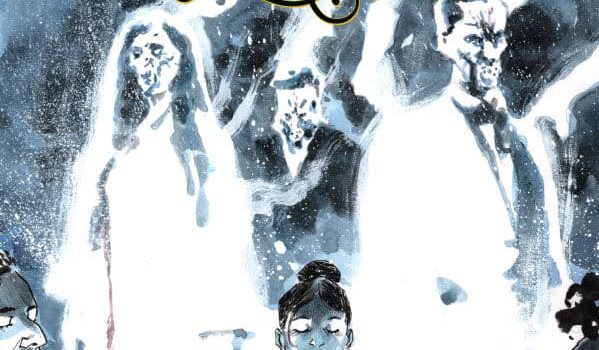
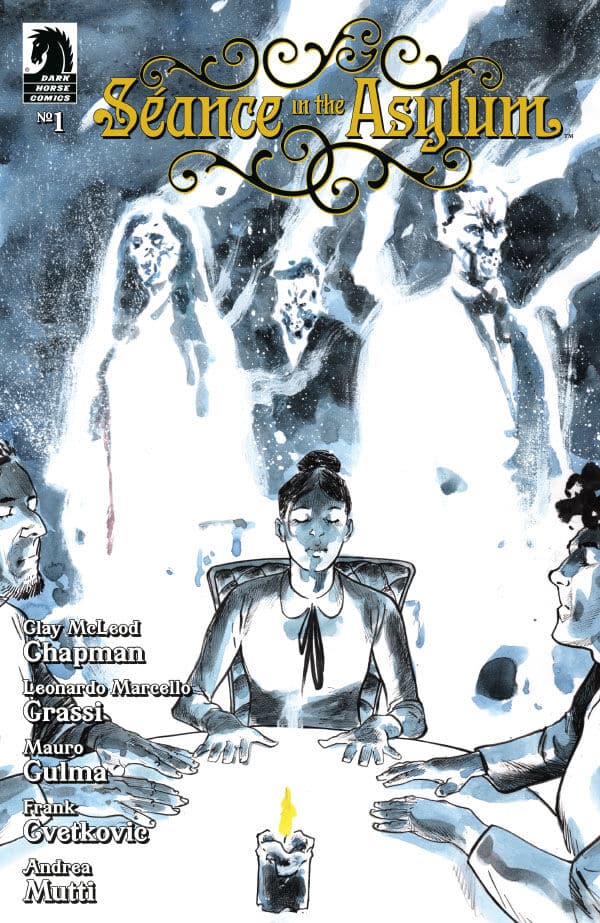
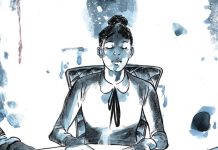







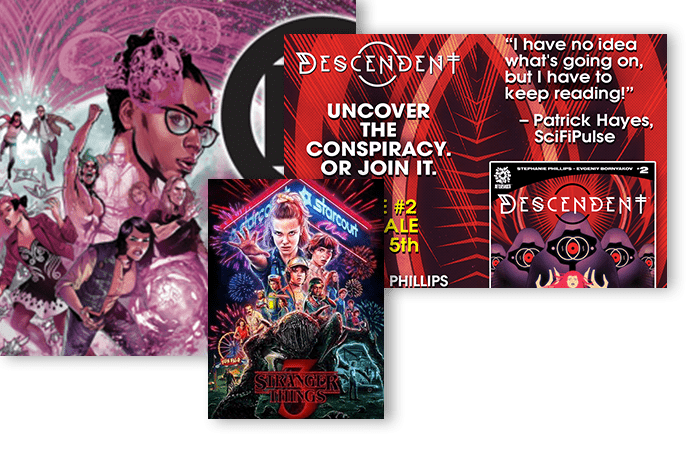
AWESOME interview! I love Chapman’s books, but I have not yet checked out his comics work! Looking forward to snagging this one! Thanks for the heads up!!
Thanks for readin!
Comments are closed.